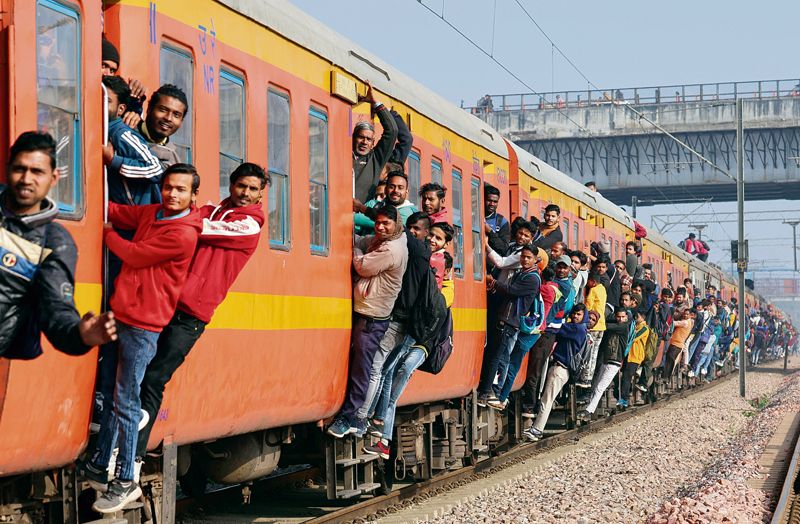
Reform: The Railways needs a strong innovation setup which will produce products/services that its existing and new customers value. Reuters
Sarabjit Arjan Singh
Former GM, Railways
THE Railways has received the highest-ever budgetary allocation of Rs 2.4 lakh crore for 2023-24. The outlay is Rs 1 lakh crore more than the allocation in 2022-23. Will such a huge investment lead to an increase in the market share of Indian Railways’ (IR) freight movement? The National Logistics Policy envisages raising the IR’s market share to 40 per cent from the current 28 per cent; this is unlikely without making changes in the way IR conducts its business.
In 1990-91, the Railways carried 62 per cent of freight traffic, which steadily declined, and by 2014-15, it had dropped to 27 per cent and since then has hovered around this percentage despite large investments in increasing capacity. This has been a matter of concern for the IR for some time and a number of committees suggested ways to halt the IR’s falling market share. It is not known to what extent the recommendations were implemented, but the fact is that the market share continued to fall. Unable to halt the decline, the IR commissioned RITES (Rail India Technical and Economic Service) to study reasons for the ‘decline in Railways’ share of total land traffic’. The RITES submitted a report in 1997.
A key conclusion of the study was that the IR’s inability to ensure ‘guaranteed transit time’ and not carrying ‘traffic on demand’ had led to commodities shifting to road transport. Moreover, there were operational and organisational issues such as the inability to meet changing customer needs and competition from other modes of transport.
The IR showed lack of commercial and marketing initiatives to attract traffic and dispel the widely held perception by the industry that the Railways’ approach as a transporter was ‘take it or leave it’.
It seems that even after 25 years since the RITES report was submitted, the situation remains basically unchanged, as brought out by the Bibek Debroy Committee in its 2015 report on ‘Mobilisation of Resources for Major Railway Projects and Restructuring of Ministry of Railways and Railway Board’.
For the National Logistics Policy to achieve its objective, and for the IR to regain its market share, it needs to rethink what it considers as its core function. The Debroy Committee states the core function as ‘business of running trains’. However, a business must also have a purpose, and the IR’s purpose must lie deeper and far beyond the core activity of running trains. How critical is the IR to Indian society becomes evident whenever it goes through a crisis such as low level of coal stocks at power plants that could lead to power outages or during the pandemic when it was called upon to create corridors for oxygen movement.
The IR is the main organ of society charged with transporting goods and passengers in public interest. It needs to increase its market share, which will only happen by expanding the customer base.
Hence, the only valid business purpose of the IR should be to attract and retain customers — those who value the services that the IR provides and are willing to pay for them. It is the customer who should determine the business and not what the IR thinks it should be.
Unfortunately, the IR does not think explicitly along these lines. It defines its core business as running trains which may indirectly imply creating a customer base, but nowhere is this stated as the purpose of the IR. As a result, the two basic entrepreneurial functions of marketing and innovation are virtually non-existent in its working.
If the IR wants to regain its market share, it has to understand that marketing is the central purpose of any sustainable enterprise. It is not sufficient to just entrust the commercial department to sell and develop the business. Marketing is broader than selling. It encompasses the whole business. The IR needs to see itself from the final outcome and from the point of view of customers.
This implies a sea change in how the IR thinks and manages its business. Now that the IR is going to be managed by the newly created Indian Railways Management Service, hopefully new thinking can be brought in. The focus must shift to marketing, which implies creating new customers. To do so, the IR needs a strong innovation setup which will produce products/services that its existing and new customers value.
The IR can adopt the model of the US railroads that has two innovation centres. One is concerned with transportation — locomotives, coaches, wagons, track, signalling and communication. The other is concerned with the development of new passenger and freight services as well as development of new markets and services and new sources of traffic.
The IR needs to recognise that marketing is more than selling; it is creating a new service that sells and for doing so the whole organisation has be a participant; each functional department doing its bit in innovating what is required to make the new initiative a success. Since innovation and marketing are the two key entrepreneurial functions, the IR needs these functions to be nurtured at the highest level. It already has a Member (Operations & Business Development); a directorate of marketing under him could focus on creating and retaining satisfied customers. It also requires a Member (Innovation) or another senior functionary looking after this function under the CEO or the Member (Operations & Business Development), who can help the organisation in continuously innovating for meeting customer expectations.
Hopefully, the IR will recognise that the purpose of its business is to create customers and innovate to provide services that customers consider valuable. If that happens, it is expected that the IR will once again become a preferred mode of transport and achieve the objective of the National Logistics Policy of 40 per cent market share. The nearly Rs 2.4 lakh crore provided in the Budget for building infrastructure will remove capacity constraints.
Join Whatsapp Channel of The Tribune for latest updates.




























